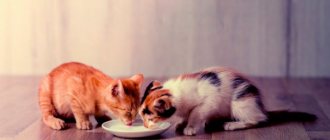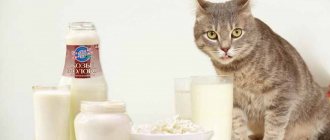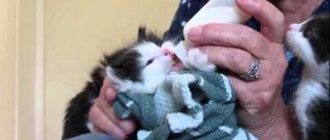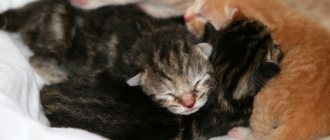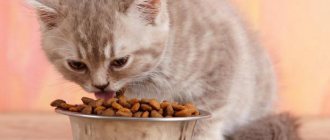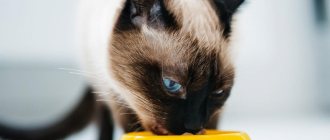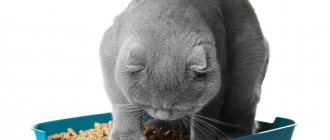A mother cat takes care of her babies independently for the first four to five weeks. Usually at this age the breeder introduces complementary foods, gradually accustoming the babies to adult food. Previously, it was a whole science with counting calories and balancing. But now there is a wide choice of what to feed a 1.5 month old kitten - veterinarians consider all options equally safe. Of course, if you follow the basic dietary requirements.
Milk replacer
Many kittens at one and a half months still eat their mother's milk, but already need additional feeding: a large litter, poor lactation, the cat is exhausted. But not all kids are ready to eat adult food. For example, large Maine Coons, Persians and Britons take longer to develop. Weak, painful offspring are also formed slowly.
A high-quality cat's milk replacer is the best thing you can feed a 1.5-month-old kitten that is developmentally delayed. It will allow you to quickly gain weight and saturate your body with essential nutrients.
Milk substitutes are produced by many well-known brands:
- Cat-Milk (Gimpet);
- Babycat Milk (Royal Canin);
- Kitty-Milk (Beaphar);
- Kittens Powder (Nurturall-C);
- Katzenmilch (Canina).
Professional substitutes contain additives - taurine, vitamins, minerals, vegetable fats. Taking into account the age and condition of the cat, sometimes they even exceed the composition of mother’s milk. Dilute the powder according to the instructions, give according to the scheme in it. To save nerves and time, it is better to purchase a bottle. It costs a penny, eliminates the need to fiddle with a pipette or syringe without a needle, getting everything dirty. It also has convenient divisions to measure out the required amount of mixture.
Kitten care
How to care for a kitten that is no longer under the care of the cat and the breeder? You took your baby to you at the age of three months (the most optimal age for separation) and now you are his mother, father and immediate family. And you need:
Trimming a kitten's claws
This procedure is easiest to do using special scissors. How to trim your baby's claws without causing pain?
If the kitten has white claws, then if you look closely, you will notice a pinkish tint. This pink area should be avoided when trimming nails.
If the claws are black, there is a high risk of injuring a sensitive area. Remove approximately 1 mm of the claw. This will be enough to prevent scratches on leather or furniture.
Read more in the article on how to trim claws.
Cleaning a kitten's ears
For some kittens, this procedure becomes their favorite. The question is - why do this? Firstly, to remove dirt. Secondly, to prevent ear mites. These tiny parasitic insects can live in the ear canals, causing infections and other problems. We remove them mercilessly!
Brushing our teeth
We wrote about this procedure above. Let us only add that the baby does not need to brush his teeth too often. Once a month is enough.
Combing out the wool
The coat (if any) should be brushed regularly, once or twice a week.
Bathing is completely contraindicated for some breeds, and for others due to severe contamination.
Baby food
It happens that it is not possible to buy good food, and there is not enough time or knowledge to create the right menu. If only the incisors have appeared from the teeth, you can feed kittens at 1.5 months with baby food in jars - meat and vegetables. Quick porridges are also suitable, but without fruit additives. It is better to breed them with a cat's milk replacer.
The first is given meat puree. There is no need to try to smear the palate and generally put your fingers in the baby’s mouth, as the “experts” advise. It’s enough to dip your finger and slightly stain your baby’s nose or lips. He will lick his lips, taste the treat and reach for the bowl himself. After two days, if there is no negative reaction, a couple of daily feedings are replaced with a mixed diet: 60% meat puree + 40% vegetable or porridge. If there are problems with the gastrointestinal tract, you can return to supplementary feeding with milk for another week or try changing the brand.
What and how often to feed a one-month-old kitten
The main nutritional element for a small kitten is cat's milk. Regardless of whether the baby is left without the support of the mother or she is feeding her baby, babies up to a month old can be taught to feed themselves. There is no need to be afraid of this, because sooner or later the cat will still switch to another food. But it’s better to let this happen under your control.
You can start feeding kittens using a bottle and pacifier.
The baby's diet should be complete (nutritious and healthy). The food should be liquid or semi-liquid (similar to regular milk). At 1 month, a kitten can eat “baby” foods:
- Goat's milk (must be diluted with boiled water in a 1:1 ratio).
- Special dry formulas for feeding kittens (can be purchased at a pet pharmacy).
- Low-fat fermented milk products without sugar.
- Liquid porridge made from semolina or rice (the rice must first be crushed).
- Boiled egg yolk (can be mixed with low-fat cottage cheese, but this puree should be fed no more than 2 times a week).
- Simple soups (boiled lean meat + broth without salt, once a week).
- Baby meat or fish puree.
- Boiled lean meat (except pork) in small quantities (must be chopped before feeding).
- Boiled sea fish without salt (boiled fillet must be carefully cleaned of bones and chopped, can be given no more than 2 times a week).
However, 30 days after birth, you should not give your kitten all the approved foods at once. Every day you need to offer one thing. Firstly, this way you can control how the baby reacted to the new food. And secondly, the cat must gradually get used to the change in food. Too sudden changes in a child's diet can lead to serious consequences (allergies, indigestion, diarrhea, vomiting, death, etc.).
When I introduce kittens to a new food, I first let the little ones try it with my finger. If kittens lick your finger, it means they like it. Sometimes these kids turn away and resist, then I resort to cunning. I smear a small amount of food on the kitten’s nose, he has to lick it (so he’ll definitely taste it). You also need to keep an eye on the kittens while eating; the smallest animals can slip and fall into the bowl. By the way, this is why kittens are given complementary foods at the very bottom of the bowl.
Photo gallery: approved products for one-month-old kittens
Goat milk can only be given diluted
Baby food in the form of purees is inexpensive, easy to find, and kittens eat it with pleasure.
Porridge for kittens should be liquid (almost like milk)
Meat can be given separately or in broth
If a kitten is left without cat milk, then it can get most of the nutrients from fermented milk products
I fed mine with Tema (classic) children's cottage cheese, without any additives like banana. Small kittens drink little water, so you need cream with 10% fat content (the approximate fat content of mother's milk), milk is not allowed. Moreover, they ate sour cream at the level of sour cream better. I set it in the morning and it stayed for the whole day. All Agusha's canned children's meats were suitable. Only after 2 months she began to accustom her to soaked dry food for Hills kittens.
Lucia, forum user
https://forum.academ.info/index.php?showtopic=221934
There should also be a bowl of clean water next to the food. Even if it seems to you that the kitten does not drink from it, the water still needs to be changed every day. After eating, dishes must be washed and dried thoroughly. It is important that the dishes are not plastic, because pathogenic microbes can settle in scratches on plastic walls.
Up to a month, kittens need to be fed up to 8 times a day. If you have a month-old baby, feed him 7-8 times, gradually reducing the number of feedings to 6 times a day. Usually such small kittens eat every 4 hours (it is necessary so that the kitten does not have time to get hungry). A warning sign may be a baby's refusal to eat. Of course, the issue may be that the food offered is unattractive, but if the kitten turns away from food several times in a row, then this is a reason to consult a veterinarian. In young animals, diseases progress faster than in adults, so every hour counts.
Starting from four weeks of age, the kitten should be given approximately 50 milliliters of food per 100 grams of weight at a time. Average kittens do not grow more than 200 grams per month, so the approximate volume of a single serving is 100 grams. But you can’t prepare baby food for more than 24 hours - saving time will have a bad effect on the baby’s health.
Should milk and milk substitutes be given?
One-month-old kittens should not be fed only cow's milk.
Every inexperienced kitten owner wonders whether it is possible to replace cat's milk with cow's milk. In fact, cow's milk is not the best nutritional option. The fact is that it contains a lot of lactose (milk sugar). This component causes something like an allergy in felines. Small kittens (up to 4 months) easily tolerate lactose, but it is not recommended to abuse it. You can purchase an alternative to cow's milk - a special substitute. This is a powder for dissolution, it can be bought at any pet store (pet pharmacy).
If you decide to feed your kitten milk or a milk substitute, you need to remember that milk cannot become the main product of the diet. After a month, it can be given to the kitten only 2 times a day. If the kitten came to you already accustomed to milk, then the lactose-containing product can be given in the form of porridge, gradually reducing the amount of milk and increasing the content of cereals and water.
There is a superstition among some breeders: if you feed a fold-eared kitten with cow's milk, its ears will “stand up.” This is supposedly due to the fact that the ears straighten when there is an excess amount of calcium in the body. In fact, all kittens need calcium, regardless of their breed. And drooping ears rise as they grow, but milk has no effect on this. It’s just that sometimes in the fold-eared breed babies are born with “defects”.
Contrary to stories, milk does not affect the shape of the ears of Scottish kittens
If you still want your kitten to eat dairy products, then offer your pet “sour milk”. Low-fat sour cream, fermented baked milk, Varenets - there are many useful and nutritious ingredients here. As a rule, cats like these products. You can also give cheeses in small quantities (the main thing is that they are unsalted). My cat, for example, loves soft cheeses (although I give it a little at a time - two or three cubes 1x1 cm).
How to accustom your pet to solid food
You need to gradually introduce yourself to solid food. But it all depends on what kind of food you choose. For example, if a kitten is fed porridge, then at first it should be a very liquid porridge, and gradually the volume of liquid is reduced by adding more cereal. If you offer your kitten meat, then first add a little boiled and chopped fillet, for example, chicken, to the broth. Gradually the amount of meat can be increased. Some people add boiled meat to porridge. The kitten will quickly taste the taste of the dish.
Cat breeders usually have no problems with porridges and soups. It is more difficult to teach a kitten to eat dishes with pieces of vegetables or meat. Of course, a baby who has been fed cat's milk will not be able to eat solid food from the first day. You will have to spend some time with the kittens while they are learning. The smaller the solid pieces of food, the easier it will be for the animal to start eating. If your pet eats only liquids and leaves pieces of meat in the plate, then try grinding them in a blender at least once. Next time the cat will specifically look for meat even in a bowl of porridge (the instincts of a small predator will make themselves felt).
You need to gradually introduce your kitten to solid food.
What foods should your pet try first?
Of course, you cannot give your kitten raw meat from the first days. The first feeding should be gentle. Many kitten owners start feeding their little pets eggs. It can be raw or boiled yolk. The raw yolk is mixed with milk or a milk substitute. A hard-boiled yolk can also be mixed with milk, but more often it is softened with vegetable oil (1 g). This is necessary to prevent the kitten from choking on the dry product.
Some owners use corn oil (1 teaspoon). Add butter and half the boiled yolk to 50 ml of milk. You should not give your kitten this kind of food all the time. After the first feeding, pay attention to the behavior and condition of the animal. An attentive owner will immediately notice if such food is not suitable for the kitten (vomiting or diarrhea may occur).
I have a familiar breeder who adds dry yeast (2 g) to kitten milk. He believes that it is good for the baby's stomach (switching to a new diet can be traumatic, and yeast makes this procedure easier). But I know that yeast can cause allergies in kittens (and even adult cats), so it is best to consult a veterinarian before using such a supplement.
Video: recipe for porridge for first feeding
Canned food
It is important to choose premium quality canned food and higher. They are not sold in supermarkets - they offer exclusively toxic garbage with a terrible composition for the price of sawdust. Exception with a very big stretch for the most extreme cases: Gourmet, Sheba, “Our Brand”.
High-quality canned food contains all the beneficial substances a 1.5-month-old kitten needs. And rather than feed your baby haphazardly from the table, it is definitely better to buy a ready-made nutritious lunch. Canned food is given according to the manufacturer's recommendation from 2 months, but fermentation can reduce this age to 6 weeks. Such elements are already semi-digested, they are easier to digest and do not burden the gastrointestinal tract. Of course, we are only talking about good food for the little ones:
- Animonda, Nature's Protection;
- 1st Choice, Brit Care, Almo Nature;
- Hill's, Pro Plan, Royal Canin.
Canned food cannot be combined with natural products; you need to choose one. The final chemical composition of the intestinal flora and gastric juice is still being formed. The ready-made diet contains easily digestible elements to which the baby’s digestion quickly gets used to. Digesting regular food requires different enzymes and more time. Therefore, the combination of canned food and natural food causes stress and disrupts the functioning of the gastrointestinal tract.
Diet of one-month-old kittens
Opinions vary on how to feed a one-month-old kitten, taking into account the substances it needs. Some people think that food is better. Others vote for natural food.
If we take as a basis food that contains everything useful for the baby, taking into account his age: microelements, additives, vitamins and more, then it will be good to give it to the baby. A plus for the owner will be the simplicity and lack of conventions that appear among owners who feed their cat homemade food. Veterinarians support this type of feeding, because it is a balanced complex that takes into account developmental characteristics. But dry food may not be suitable for an animal, because they are all individual. There is a possibility that some vitamins are missing, but we cannot check this at home. Or you are an experienced animal breeder, who has raised many cats and cats, and does not trust strange squares. There are different situations, so let's look at both types. And you decide for yourself which one is suitable. There are basic rules that you should not forget:
- Feeding may consist of dry food or natural food. Under no circumstances should they be combined. The reason is that different products do not take the same amount of time to digest. For a kitten who is a month old, such a “buffet” will cause stress, and possibly diseases of the gastrointestinal tract. In addition, a pet eating dry formula consumes more liquid than one eating a natural menu, which also affects the absorption process.
- If you have made a choice of what you can feed a small kitten and you prefer dry food, then stick to one brand. When mixing products from many companies, you can cause your pet many stomach and immune problems. After all, each food has its own levels of microelements, and if they are changed very often, vitamin deficiency is possible, which can harm the baby for the rest of its life.
- Don’t skimp on ready-made food; choose “premium” or “super-premium” class. Cheap brands with bright packaging contain almost no usefulness; they are analogous to “fast food”. The cat will be very grateful for high-quality ready-made meals and will delight you with playfulness and smooth fur.
Natural food
Supporters of natural animal nutrition, in order to train a kitten 1 month from birth, must comply with the following conditions:
- Diet variety. From the very beginning, accustom your baby to any type of food. This will help you in the future not to become a “picky eater” who eats only meat and will contribute to a complete and healthy diet.
- Avoid feeding from the table. If you give your baby such food, he will consume a lot of extra spices and salt, which is completely unnecessary for a growing body. In addition, you can get a “beggar” who does not allow you to sit quietly at the table.
What is initially suitable for small kittens, besides milk? You can give cottage cheese. To get accustomed to a new taste, you can mix cottage cheese with milk until a thickness similar to sour cream is formed. Cottage cheese is useful due to the large amount of calcium, which helps prevent the disease rickets.
Chicken yolk, as well as protein, is another benefit; it is given from 2 months. At the beginning, also stirring with milk.
The following list will be useful:
- broth-based soups without spices;
- boiled vegetables;
- milk porridge and meat broth.
But such lenten dishes are loved by a rare animal. After all, a cat is a hunter. The meat will be eaten by him without delay. Meat for the baby is chosen that is not fatty, first boiled and cut into portions. Cooking these meat products is required to avoid infection with helminths.
Young cats grow up very quickly, and they need a sufficient set of vitamins and minerals for their young bodies. Natural dishes do not always contain a sufficient amount of nutrients. Therefore, purchase vitamin complexes sold at any pet store. There are complexes depending on the months lived, which are easy to select.
Also, for vitamin enrichment, you can grow, for example, wheat, which is added to a bowl or simply placed in an accessible place so that, if necessary, the animals themselves bite off the required amount of grass.
Don't forget to provide food variety. Feeding only cereals, meat or fish alone is very harmful. By the way, it’s better not to lean too hard on the fish. Doctors have proven that pure consumption of fish products contributes to kidney disease. If you want to do castration in the future, then you will definitely have to exclude fish from the menu. Do not add salt to food for our little brothers.
A curious little face must have free access to water. It is advisable to change it daily to keep it clean and fresh. Before changing, pour boiling water or hot water over the containers.
Maintain temperature conditions for your furry friend's food. It is given at approximately room temperature. Too hot and too cold damage the taste buds.
Ready-made food for one-month-old kittens
Currently, the market provides good food not only for adult cats, but also for small ones.
Several suitable brands with a good composition from the “premium” segment:
- Acana offers 3 flavors: chicken, lamb and fish. The advantages are the balanced components and the absence of chemical dyes and grains. The disadvantages of the product include the lack of preventive kits and a small selection of flavors.
- “Royal Canin” - this brand, despite the “premium” class, has an affordable pricing policy. In addition, the advantages are the presence of a veterinary line and a wide variety of flavors.
- “Almo Nature” - the advantages of the brand lie in triple control of the quality and naturalness of the ingredients. This Italian package contains 53% meat ingredients and 14% non-allergenic rice. The main disadvantage is the high cost, but if you look from the other side, the price is justified by the quality.
Dry food
According to nutritionists, before 3 months. Don't give kittens dry food often. It is offered once or twice a day instead of the usual canned food. The highest demands are placed on this type of feeding. Ideally it should be holistic with around 50% meat content and no grains.
Low quality ingredients, fermented and concentrated - a powerful poison that causes irreparable harm to a growing body in just a few weeks. High-quality dry food, on the contrary, will satisfy all nutritional needs:
- AATU, Applaws, Barking Heads;
- GO and NOW Natural holistic lines;
- Summit holistic, Hill's, Royal Canin.
Hard granules are still difficult to bite through, but whole ones can be choked. First, they are steamed with very warm water, but not boiling water. Pour a little into a bowl and cover with a lid, let stand for 5-7 minutes until the balls are completely swollen. Then check if it is hot, and you can feed the kittens. At 1.5 months, the daily requirement varies greatly among different brands. There are recommendations on the packaging, taking into account age and weight - it is important to follow them.
Kitten 1.5 months and litter box
The tray for that baby should not be high so that he can easily climb in and out. You need to accustom your kitten to the litter box as soon as it arrives at your home. Do not shout or scold your baby if he does not immediately understand what you want from him. Place the kitten in the litter box after sleep and after eating. Stroke him there and gently persuade him to do “his business.” If your kitten pees in the wrong place in front of you, pick him up and put him in the litter box. And wipe the place where the kitten has done mischief and spray it with a special spray - an odor absorber.
Natural products
The digestion of cats at the genetic level is very different from the characteristics of the gastrointestinal tract of humans and dogs. Beef is no closer to Murka than ready-made food from a bag. Natural food will include mice, birds, frogs, lizards, beetles and grass as a source of coarse fiber.
The word “natural” itself sounds very attractive, close to nature. It seems that this is the only correct way to feed a small kitten at 1.5 months old - with fresh, real food, and not with something incomprehensible from a jar. And this is wonderful, but it’s quite difficult in terms of selecting an individual menu:
- Medium fat cottage cheese is the first complementary food. You can add a raw yolk to it or crumble a boiled egg. Protein cannot be eaten raw; it binds and removes B vitamins. Sometimes cottage cheese is replaced with non-acidic yogurt, which is better if homemade. Dairy products are given in the morning and every other time at lunch.
- Meat takes up only about half of the diet - beef, rabbit, lamb, chicken, turkey. In nature, a cat eats prey along with bones, intestinal and stomach contents, liver, skin, feathers or fur. Feeding kittens only meat leads to chronic renal failure and toxic liver damage. The piece is frozen for three days and finely chopped. Minced meat does not linger in the gastrointestinal tract, “flying” in vain. Instead of freezing, chopped pieces can be kept in boiling water for 10 minutes.
- Vegetables are added to the meat in a ratio of 40/60 - carrots, zucchini, sweet potatoes, cauliflower, boiled or grated raw. Small kittens at 1.5 months. You should not feed vegetables often; at this age, the emphasis is on a milk-meat diet. Twice a day is enough to meet fiber needs.
- Cereals are digested only fermented, from the intestines and stomach of prey or from industrial feed. Unpolished boiled rice is included in the menu as ballast to prevent protein poisoning. This scourge specifically threatens domestic cats, because they move too little.
- Any offal, but only in boiled form. Chicken hearts and stomachs can be given scalded and finely chopped. Liver is added to meat to diversify food sources. For example, this serving option: turkey 30% + chicken liver 30% + vegetables or grains 40%.
Fish is a very controversial product. It is useful for healthy cats, despite the mountain of myths. In nature, for many cats, this is half the diet.
But feeding small kittens fish is not recommended. If you decide to include it in the menu, it should be sea, white and lean, boiled and thoroughly deboned.
Safety instructions
Basic care in an apartment environment involves ensuring complete safety for the new resident. Within the walls of any home and open street space, various dangers can lurk for a small pet. Before you bring a kitten into your home, you should make sure that the following negative conditions are not present in the apartment:
burning candle
- Open windows and balconies, from which a small kitten can fall out of curiosity , or by reaching for a bird flying by.
- Unmasked electrical wires, when played with and biting, can expose a baby to a fatal electric shock.
- Protruding parts of furniture. Kittens, being playful, may not calculate the trajectory of their jump and get hurt on protruding sharp interior objects.
- Household appliances isolated from animal access , especially a washing machine, into the drum of which the animal can quietly climb.
- Open fire in the form of a fireplace or candles is a great danger for inquisitive kittens. It is advisable to isolate the animal from such a problem as much as possible.
- All small sharp objects : knives, forks, needles and others must be hidden from the access of the new tenant.
- Danger comes from household chemicals , medications, seasonings and any detergents. Such compositions are fraught with severe poisoning for kittens, which ends in death. This also applies to indoor plants, some of which are poisonous to animals.
Doors can be considered as additional sources of threat. Kittens at an early age do not yet have sufficient coordination and do not have a sufficiently developed sense of self-preservation. The new owner should open and close the doors for the first time, after making sure that there is no kitten sitting behind them. The same applies to assembling and disassembling pieces of furniture.
Playing kitten
General rules
The suckling babies are fed additionally when they clearly stop eating enough on their own: they squeak, tug at their breasts with force, and do not let the cat go away from them. Or the mother herself leaves due to cessation of lactation, forcing her to leave a half-starved litter. If there is no milk at all, they switch to feeding in small portions every 3-4 hours with a night break of 6-7 hours:
- Leftover food is always removed, since a 1.5 month old kitten can only be fed under supervision. With the introduction of complementary foods, water is placed in wide, shallow and stable bowls. It is changed twice a day.
- Food should be lukewarm or at least room temperature. Cold and hot food causes indigestion. Long-term consequences include inflammation of the small intestine, chronic gastritis, colitis and other joys.
- Digestion is still very vulnerable, and the body is developing at a speed that is crazy by human standards. Therefore, it is important to follow the regime so that the gastrointestinal tract works well. Products are only high quality and fresh.
- To properly feed small kittens at 1.5 months, it is important to introduce only one new product per day. If your baby reacts with diarrhea, vomiting or allergies, you won’t have to guess what exactly caused the reaction.
- The menu is adjusted upon reaching 4 months. Increase the portion and reduce the number of meals to three times a day. Grown-up kittens eat almost like adults - in larger pieces, learning to tear apart the “prey”. This is good for the gums and prevents tartar deposits.
When feeding dried or canned food, it is important to monitor the condition of the dental system. Inflamed gums, plaque or an unpleasant odor indicate the need to change the brand. If the choice fell on natural food, it is better to create a menu together with a competent veterinarian.
Rules for introducing complementary foods
At 1.5 months, you should carefully select foods for your pet. When introducing complementary foods to a kitten, you must follow medical recommendations:
- All food should be heated to +24°C. Food that is too hot or cold can harm your pet's digestive system.
- Boiled cereals should have a very liquid consistency. When using milk to cook porridge, it must be diluted in equal proportions with water.
- Nutrition should be varied and balanced.
- The frequency of meals per day is up to 5 times, with an interval of 3 hours between meals.
- Raw minced meat for kittens is strictly prohibited.
- Pork in any preparation is also prohibited. This type of meat is too heavy for the kitten’s digestive tract and can cause a number of serious diseases.
- New products are introduced into the menu gradually: 1 product per day, in small quantities. When introducing a pet to a new treat, the owner must monitor the reaction of his body to avoid allergies or digestive disorders.
- Food should not remain in the bowl. She cleans up after the meal. Starting from 1.5 months, the kitten needs to be gradually accustomed to a certain food intake.
An actively growing baby needs meat. You can give chicken and beef, but without salt and spices. Meat products should be thoroughly chopped.

